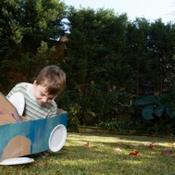 I recently saw a hot dog commercial that depicts a mom and son shopping in a superstore. You hear the mom saying, “No, no, no, no, no” as the son jumps on a trampoline, plays with drums, rides across the store on a scooter, finds a large kayak, and asks for a case of energy drinks. When the boy picks up the hot dogs, the mom says, “Yes,” and the voice-over declares, “In a world filled with no, it’s nice to finally say yes.”
I recently saw a hot dog commercial that depicts a mom and son shopping in a superstore. You hear the mom saying, “No, no, no, no, no” as the son jumps on a trampoline, plays with drums, rides across the store on a scooter, finds a large kayak, and asks for a case of energy drinks. When the boy picks up the hot dogs, the mom says, “Yes,” and the voice-over declares, “In a world filled with no, it’s nice to finally say yes.”
This commercial caught my attention and made me laugh because it was so true and sounded just like the chorus of “no” I often hear from the moms of young children I’m surrounded by at playgroups, parks, and the pool.
As parents, our job is to teach children what is acceptable, to set limits, and to instill appropriate boundaries, and this often involves chasing our kids around, telling them no. Saying no is an inevitable part of being a caregiver, but the problem with constantly saying no arises when we do so without any explanation or attempt to let kids be kids.
Kids are naturally curious and are driven to explore the world around them. Thus, they get into things they shouldn’t, touch stuff we wish they wouldn’t, and want to try things we’d rather they avoid. There are times we have to tell them no in order to protect them or the things around them, but when we constantly tell them no, we stifle their sense of wonder and deny them opportunities to grow and learn.
In my self-esteem workshops, I often talk about the various messages we hear growing up and how they contribute to the foundation of our sense of identity and our level of self-esteem. When kids are constantly told no, they become susceptible to internalizing this message as “I am bad” or “I am wrong.” This can lead to a lifetime of issues with feeling flawed and inadequate.
It is so important to be aware that our words and actions toward our toddlers play a role in shaping their identities and laying the groundwork for their futures as adults. We must be mindful of how we speak to them and strive to encourage, versus inhibit, their sense of wonder. Before you say “no,” stop and ask yourself, “Is this really hurting anyone or anything?” Maybe there is a way you can bridge the gap between your anxiety and your child’s need to explore, grow, and develop.
If your child wants to use a butter knife, fine; rather than snatching it away, explain that knives are sharp and hold it together as you teach her how to butter the bread. If your child wants to dump water out of a cup, rather than yelling no, redirect him to the bathroom and let him do it over the tub. Or explain that it is not appropriate in a restaurant but they can try it at home during bath time. Allowing children the opportunity to try the things that capture their interest, versus telling them no, helps to instill a sense of independence and capability.
When something is unsafe, instead of simply saying no to kids, attempt to follow the no with an explanation that helps them to learn and understand your reasoning.
When something is unsafe, instead of simply saying no to kids, attempt to follow the no with an explanation that helps them to learn and understand your reasoning. For example, “No, honey. That is not safe and I don’t want you to get hurt.” Or, “No, please don’t touch that because it is breakable.” When kids have a clear understanding of why you are denying them the ability to explore what they are curious about, they are typically better able to attribute the no to external factors, rather than make false assumptions that they are somehow intrinsically flawed in their interests and desires.
If your child wants to touch the grill, gently pull their hand away and explain to them, “This is a grill for cooking food. It gets very hot, so we have to be very careful not to touch it. It cooks the food, but it could hurt your hand.”
By taking the time to provide an explanation, you are not only protecting your child in the moment, but also using the interaction as a teaching opportunity—distracting them from what they were about to do while also giving them information they can learn from and remember in the future.
I’m not saying you should be a pushover with your kids. I recognize parenting is demanding. It’s often hard to follow this advice and appease all of our children’s whims when we are busy tending to everything else on our plates, have had a long day, and have little energy to give. Yet taking the time to consciously say no and effectively redirect children can play a positive role in their development and ultimately make things easier.
Of course, there will be times when kids test your boundaries, push your buttons, or flat-out defy you. In these instances, it is important to be direct and firm with your messages. The “if, then, since” formula can be helpful: “Hitting hurts. If you don’t stop hitting your brother, then you will go to your room.” (Wait a few seconds for the behavior to change.) “Since you did not stop hitting your brother, it’s time to go to your room.” Again, this sends a clear message and gives kids the opportunity to learn the rules and expectations rather than wonder why they are being disciplined or told to stop.
When we treat kids with the same respect we would give a peer, things tend to go more smoothly. Let’s strive to make our go-to responses to our children’s actions be from a place of compassion, calm, and a desire to teach rather than from one of frustration, anxiety, and a need to control. In doing so, not only can we ultimately help foster positive self-esteem in our children, but we may prevent the meltdowns, tantrums, and power struggles that often follow “no.”
© Copyright 2017 GoodTherapy.org. All rights reserved. Permission to publish granted by Megan MacCutcheon, LPC, GoodTherapy.org Topic Expert
The preceding article was solely written by the author named above. Any views and opinions expressed are not necessarily shared by GoodTherapy.org. Questions or concerns about the preceding article can be directed to the author or posted as a comment below.

 Learning Through Play: The World as Your Child's Classroom
Learning Through Play: The World as Your Child's Classroom Helping Young Children with Emotional Regulation: Tips for Parents
Helping Young Children with Emotional Regulation: Tips for Parents Indiscriminate Affection and Children: The Real Stranger Danger
Indiscriminate Affection and Children: The Real Stranger Danger